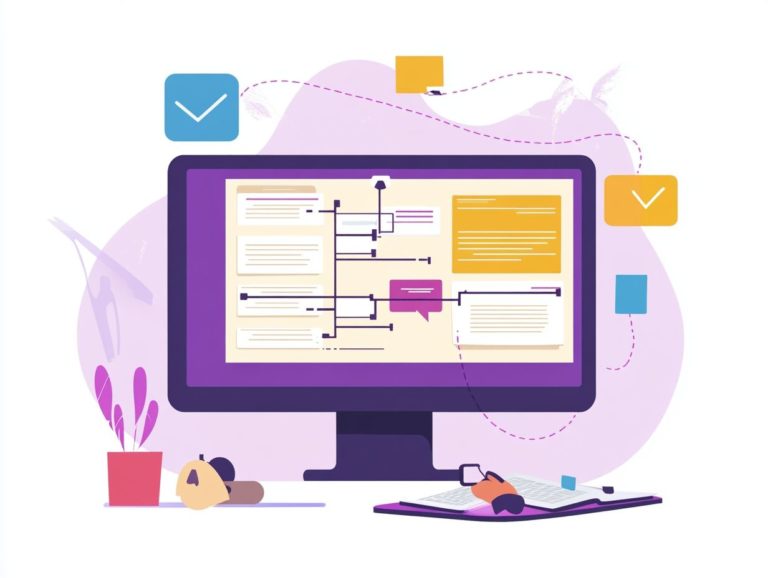Cloud Migration for Small Businesses: Tips
In today s fast-paced digital landscape, cloud migration is not just a trend; it is essential for small businesses aiming to enhance efficiency and scalability.
This guide unpacks the essentials of cloud migration, defining the process and illuminating its myriad benefits. You will explore whether cloud migration is the right fit for your business, uncover practical preparation tips, and receive guidance in selecting the ideal cloud service provider.
Discover best practices that ensure a seamless transition and strategies for maximizing your investment in the cloud. Are you ready to unlock the potential of cloud technology? Let s dive in!
Contents
- Key Takeaways:
- What is Cloud Migration?
- Is Cloud Migration Right for Your Small Business?
- Preparing for Cloud Migration
- Choosing the Right Cloud Service Provider
- Ensuring a Smooth Cloud Migration Process
- Maximizing the Benefits of Cloud Migration
- Optimizing Efficiency and Cost Savings
- Frequently Asked Questions
- 1. What does cloud migration mean for small businesses?
- 2. Why should small businesses consider migrating to the cloud?
- 3. What are some tips for a successful cloud migration for small businesses?
- 4. How can small businesses ensure the security of their data during a cloud migration?
- 5. Are there any challenges that small businesses should be aware of when migrating to the cloud?
- 6. What happens to a small business’s data and applications after they have migrated to the cloud?
Key Takeaways:

- Cloud migration is a game changer for small businesses!
- Benefits include reduced costs and increased efficiency.
- Assess your business needs and goals before deciding if cloud migration is right for you.
- Proper planning and consideration of key factors are crucial for a successful cloud migration process.
- Choose a reliable and reputable cloud service provider and be prepared for potential challenges.
- To maximize the benefits of cloud migration, focus on optimizing efficiency and cost savings.
- Achieve this through proper training, utilization of cloud services, and regularly reviewing and adjusting your cloud strategy.
What is Cloud Migration?
Cloud migration involves transferring your digital assets, applications, and data from on-premises servers or outdated systems to cloud environments like AWS, Microsoft Azure, or Google Cloud. To ensure a smooth transition, it’s important to learn how to develop a cloud migration strategy.
By embracing this transition, you empower your small business to use modern cloud services. This not only enhances data security and fosters collaboration but also ensures business continuity, especially when you follow a thorough cloud migration assessment and planning.
It also helps reduce operational expenses typically associated with traditional IT infrastructure, allowing you to allocate resources more effectively.
Defining the Process and Its Benefits
The cloud migration process unfolds through several key steps, including cloud assessment, application cutover, and the intricacies of data migration. Each of these phases offers distinct advantages, such as reduced operational expenditures and enhanced data integrity.
It begins with a comprehensive assessment of your existing IT infrastructure. This crucial step allows you to pinpoint which applications stand to gain the most from cloud capabilities, laying the foundation for a customized migration strategy that meets your unique needs.
Next comes the application cutover, where critical applications transition to the cloud. This move not only boosts accessibility but also significantly enhances scalability, giving you the flexibility to adjust resources as your business evolves.
Data migration, often seen as one of the most daunting tasks, ensures that your sensitive information is transferred securely, fostering trust and ensuring compliance. As you navigate these stages, you can unlock performance optimization and align your operations with dynamic cloud strategies, paving the way for greater agility and growth.
Is Cloud Migration Right for Your Small Business?
Determining whether cloud migration is the right choice for your small business requires a careful evaluation of your unique needs, technical capabilities, and long-term objectives. Utilizing resources like cloud migration checklists can help you make an informed decision.
This thorough assessment will empower you to navigate potential challenges, such as vendor lock-in and data security, with confidence and clarity.
Assessing Your Business Needs and Goals
Assessing your business needs and goals for cloud migration means diving deep into operational expenditures and current IT costs while evaluating cloud requirements that align with your strategic objectives and growth plans.
This process starts with a thorough inventory of your existing IT assets, helping you understand how they support daily operations. As a small business, it is crucial to reflect on whether your current systems adequately meet your communication and collaboration needs.
Utilizing project management tools can be incredibly beneficial during this evaluation phase. These tools streamline the identification of productivity gaps and highlight operational bottlenecks, making it easy to track tasks and deadlines.
This sets the stage for a seamless transition to a cloud environment that not only meets today s demands but also strategically positions your business for future scaling.
Preparing for Cloud Migration

Preparing for cloud migration requires a well-crafted transition plan that details governance policies, risk management strategies, and employee training initiatives.
This comprehensive approach is essential for ensuring a seamless migration experience while minimizing potential disruptions.
Key Considerations and Planning Steps
Key considerations and planning steps for your cloud migration involve grasping the complexities of data migration and evaluating scalability options.
Additionally, conducting a thorough security check protects sensitive information throughout the process.
To successfully navigate this transformative journey, you need to assess your existing infrastructure and identify which applications and data sets will migrate seamlessly. It s essential to pinpoint potential challenges, such as data loss, application compatibility, and latency issues that could arise during the migration.
Choosing the right scalability options means ensuring that your cloud environment can grow with your business’s needs while maintaining performance and avoiding excessive costs. Robust security measures, including encrypted data transfers and multi-factor authentication (a security process that requires more than one method of verification), should be woven into your migration strategy to safeguard against breaches and ensure compliance with regulations.
Choosing the Right Cloud Service Provider
Selecting the ideal cloud service provider for your business requires a thorough evaluation of options like AWS, Microsoft Azure, and Google Cloud.
Consider factors such as partner solutions, pricing models, and the unique requirements of your organization. Making the right choice can significantly impact your operations and overall success.
Factors to Consider and Questions to Ask
When selecting a cloud service provider, it s essential to weigh factors like cost efficiency, technical expertise, and robust security measures. Ask key questions that can help you assess their capabilities and whether they align with your business needs.
Thoroughly examine how the provider’s pricing structure fits within your budget, ensuring no hidden fees could send your costs spiraling. Understanding their level of technical support and expertise is critical, as it can significantly impact the smoothness of your migration.
Security measures like data encryption (the process of converting information into a code to prevent unauthorized access) and compliance with industry regulations are paramount in protecting your sensitive information.
Don t hesitate to ask pointed questions about uptime guarantees, disaster recovery options, and future scalability. These inquiries will provide greater clarity and guide you toward a more effective cloud migration strategy.
Ensuring a Smooth Cloud Migration Process
To ensure a seamless cloud migration process, you must adhere to best practices and proactively address cloud migration risks and mitigation strategies commonly encountered.
By leveraging managed services, you can optimize performance and minimize disruptions during the transition, setting the stage for a successful shift to the cloud.
Best Practices and Common Challenges

Implementing best practices during your cloud migration is essential for mitigating challenges like data integrity issues, insufficient employee training, and unexpected technical difficulties, as outlined in our guide on understanding cloud data migration.
To create a seamless experience, prioritize comprehensive employee training programs that equip your teams with the necessary skills and knowledge. This proactive approach builds confidence and enhances the overall adoption of new systems.
Incorporating proactive risk management strategies into your migration plan allows you to identify potential pitfalls before they escalate. By regularly assessing data integrity and following a structured migration timeline, you foster an environment of stability and reliability.
This ultimately safeguards your valuable data assets and ensures a smoother transition.
Maximizing the Benefits of Cloud Migration
To truly maximize the advantages of cloud migration, focus on cost savings and operational efficiency.
Emphasizing the use of cloud-based applications can significantly enhance real-time collaboration among your teams and stakeholders, transforming the way you work together.
Don t miss out on these opportunities! Start your cloud migration journey today and unlock new possibilities for your business!
Optimizing Efficiency and Cost Savings
To improve efficiency and achieve significant cost savings, analyze the specific types of workloads your business handles and adopt online services that store and manage data, which align seamlessly with your operational requirements.
By evaluating your current and anticipated workloads, you can identify the best cloud architecture to meet your unique needs. This smart strategy boosts your performance and saves money while minimizing resource wastage, ensuring that your investments yield maximum returns.
Implement performance optimization techniques, such as autoscaling (automatically adjusting resources based on demand) and load balancing (distributing workloads evenly), to cultivate a more responsive cloud environment.
When you select the right cloud services, you streamline your operations and position yourself to seize new opportunities while maintaining a competitive edge in your industry.
Frequently Asked Questions
Here are common questions small businesses have about cloud migration:
1. What does cloud migration mean for small businesses?
Cloud migration for small businesses is moving data, applications, and services from on-premise servers or traditional IT infrastructure to a cloud-based platform, making it crucial to understand cloud security for small businesses.
2. Why should small businesses consider migrating to the cloud?

Migrating to the cloud offers numerous benefits for small businesses, including:
- Cost savings
- Increased flexibility and scalability
- Improved collaboration and accessibility
- Enhanced data security and disaster recovery capabilities
3. What are some tips for a successful cloud migration for small businesses?
Tips for a successful cloud migration include:
- Perform a thorough analysis of your current IT infrastructure
- Choose the right cloud service provider
- Create a migration plan and timeline
- Involve your employees in the process for a smooth transition
4. How can small businesses ensure the security of their data during a cloud migration?
Ensure your data is secure during a cloud migration by:
- Choosing a reputable and secure cloud service provider
- Implementing strong access controls and encryption measures
- Regularly backing up your data
5. Are there any challenges that small businesses should be aware of when migrating to the cloud?
Yes, some challenges include:
- Compatibility issues with legacy systems
- Data transfer and integration difficulties
- Potential disruptions to daily operations
Planning and preparing for these challenges can minimize their impact.
6. What happens to a small business’s data and applications after they have migrated to the cloud?
After a small business completes its cloud migration, their data and applications are hosted on the cloud service provider’s servers. This process involves understanding how to migrate to the cloud, allowing them to access their data from anywhere with an internet connection, while the provider handles maintenance, updates, and backups.
What benefits of cloud migration are you most excited about? Reach out to a cloud provider today to learn more!






